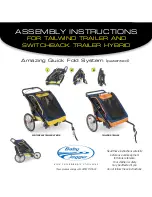
12
IV User Manual Pedelec with front motor
5 Assistance by the electric motor
5.1 Operating principle of assistance
The motor provides support as soon as you switch the as-
sistance on and start pedalling.
The thrust delivered by the motor depends on three factors:
•
Your own pedalling effort
The motor adapts to the force you apply. If you
pedal harder, e.g. uphill or when setting off, the
power sensor detects this and increases the thrust
accordingly. However, the thrust is limited by the
maximum motor output.
•
The assist level you have selected
With the
"high assist level / HIGH"
the power deliv-
ered by the motor is double your own effort (1 : 2).
With the "
medium assist level / MID
", the power
delivered by the motor matches your own effort
(1 : 1). With the
"low assist level / LOW / ECO"
, the
power delivered by the motor is half your own ef-
fort (1 : 0.5).
The speed at which you are currently travelling
When you set off on your Pedelec, the assistance increases
as you build up your speed until your bike reaches its
maximum speed of roughly 19 km / h. The assistance
then reduces automatically and switches off at roughly
25 km / h. This happens irrespective of the gear you are
using.
Variation in electric assistance
Propulsive power
Speed
increasing pedal
power and
assistance
reducing
assistance
assistance
switched off
Power assist mode = 1 : 2
Pedal force
19 km / h
25 km / h
Propulsive force (pedal force +
electric assistance)
Electric assistance
1.0
2
Distance
The distance you can travel using the power assist with
the battery fully charged depends on several factors:
•
Ambient temperature
If it is colder, you will travel a shorter distance
with the same battery charge.
To maximise the distance you can travel, keep the
battery in a heated room so that it is at room tem-
perature when you fit it on your Pedelec.
As the battery discharges when the motor is in use,
it generates enough of its own heat to not lose too
much of its power at low temperatures.
•
Selected assist level
If you want to cover a large distance assisted by
the motor, select the lower gears, i.e. the ones
that are easier to pedal. Also change to
"low assist
level / LOW"
.
•
Handling
If you are riding in gears that are harder to pedal
and select a high level of assistance, e. g. when
riding uphill, the motor will provide support with
plenty of power. However, this leads to higher con-
sumption, as with driving a car at high speed on
the motorway. You will therefore have to recharge
the battery sooner. You can conserve energy when
riding your bike not just by turning the pedals, but
also by applying even pressure throughout each
crank revolution.
Содержание Fast Pedelec
Страница 2: ...I Instru es gerais de utiliza o Portugu s Raleigh Univega GmbH 2013...
Страница 68: ...I Instru es gerais de utiliza o 67...
Страница 70: ...II User Manual Fast Pedelec English Raleigh Univega GmbH 2013...
Страница 75: ...6 II User Manual Fast Pedelec...
Страница 98: ...III User Manual Pedelec with centre motor English Raleigh Univega GmbH 2013...
Страница 105: ...8 III User Manual Pedelec with centre motor...
Страница 126: ...IV User Manual Pedelec with front motor English Raleigh Univega GmbH 2013...
Страница 148: ...IV User Manual Pedelec with front motor 23...
Страница 150: ...V User Manual Impulse Pedelec English Raleigh Univega GmbH 2013...
Страница 157: ...8 V User Manual Impulse Pedelec...
Страница 183: ...VII User Manual Groove Pedelec English Raleigh Univega GmbH 2013...
















































